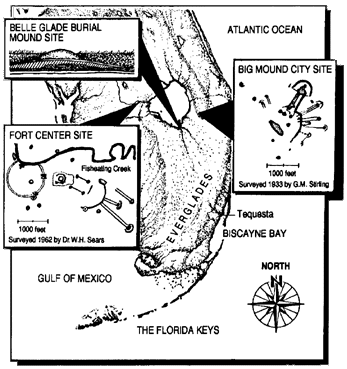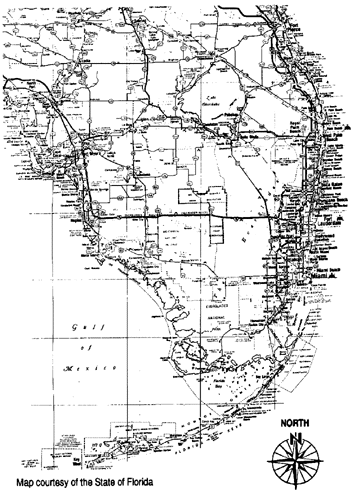spiritofatlantis.com | Duane K. McCullough

Major Mayami mound sites near Lake Okeechobee
Although many have heard of the Calusa and the Tequesta Indians, the Mayaimi tribe of Southern Florida
was perhaps the most influential of the pre-Seminole family.
Mound site information from the book: A CRACKER HISTORY OF OKEECHOBEE by LAWRENCE E. WILL / Glades
Historical Society.
V1
Chapter 2: The Mayaimi Mounds
1/ There is a legend told by some Seminole Indians of Florida
that "long time ago" a family tribe came up the
Caloosahatchee River (A major river of southwest Florida) and
settled near the west bank of Lake Mayaimi.
2/ There they built some village mounds and dug a canal
linking the river with the lake.
3/ Later they were driven to the eastern side of the lake by a
war-like tribe - perhaps the Calusa tribe, and built another
group of village mounds.
4/ Evidence of these shell filled mounds can still be found
today - although many smaller associated mounds were probably
destroyed early this century to pave the hard
surface roads that surround the shallow region of the lake.

Southern Florida today.
5/ On the west bank of what is now Lake Okeechobee, near a
site called Ft. Center and Fisheating Creek, are a series of
Indian mounds adjacent to a large circular canal that measures
about a quarter of a mile in diameter.
6/ Near the circular canal is a thirty-foot mound with a
sloping diameter of approximately 125 feet.
7/ Across the lake, some twelve miles inland from the eastern
shore, lies Florida's largest collection of prehistoric
earthworks known as "Big Mound City" - in which the
most substantial mound once measured roughly 300 feet by 800 feet
across and nearly 25 feet high.
8/ Other surrounding mounds measuring thirty to forty feet in
diameter lie within and outside a large fifty-foot wide
semi-circle causeway that calculates to almost a quarter of a
mile in diameter.
(Apparent access to this particular mount site
may be restricted due to private property rights)
9/ Twenty miles to the southwest - just west of the town of
Belle Glade and near the southeastern shore of the lake exist the
"Chosen Mounds".
10/ In 1933-34 archeologist from the Smithsonian Institution -
together with the State of Florida Works Progress Administration,
discovered that by calculating soil layers and comparing buried
artifacts within, these mounds have been occupied by tool making
Indians for possibly two-thousand years.
(Recent excavations by Dr. Williams Sears, professor emeritus of
anthropology at Florida Atlantic University, has revealed pottery
evidence that date the native inhabitants of the Belle Glade
region to much older than the birth of Christ)
11/ Now because the Seminole Indians of Florida are believed
to be relatively newcomers to the region that migrated from the
north to escape colonial oppression, their legend about a family
tribe arriving from the Gulf realm "long time ago"
would barely qualify for two-hundred years - let alone
two-thousand years.
12/ But for now, let us assume that the legend of the mound
builders was passed on to the Seminoles by local lore.
13/ With this in mind, the first mounds mentioned in the
legend - the ones at Ft. Center and Fisheating Creek, revealed
some evidence that may prove the Seminole story true.
14/ In 1961 the Florida Archeological Society uncovered
fifty-four upright long bodied skeletons on top of what appeared
to be the older burials of a smaller boned race of people with
elongated skulls and receding fore-heads - possibly the original
mound builders.
15/ The fifty-four long bodied skeletons uncovered on top are
characteristic of the Calusa Indians of southwest Florida, which
were known to be a very large race of American Indian - perhaps
because of a high "Fluorapatite diet" found within the
region.
(Fluorapatite is a nutritional crystalloid salt containing
calcium phosphate of fluorine, which, if digested properly, is
capable of promoting "flexible bones" in the early
stages of human growth - thus permitting a "stretching"
of the skeletal frame and resulting in a physically larger class
of human being)
16/ But the smaller boned race of people buried underneath the
larger Indians revealed features of a Central American family of
tribes known as the Mayas.
17/ Which if this if the case, the first Mayaimi Indians may
have been Mayan colonist that migrated from the Mayan region of
the Yucatan peninsula - some five-hundred miles southwest of
Florida, via a sailing raft and the prevailing Gulfstream
current.
18/ Now that there may be more than a phonetic link between
the Mayaimi natives of southern Florida and the Mayan family
tribes of Middle America, this story about ancestral America must
include the most important legend in Central America - the story
of an ancient Indian king named Quetzalcoatl and his eastern
departure toward the sunrise onboard a raft made from reptile
skin and wood.
19/ But first, a little review of Middle American history.
Return to Volume 1

